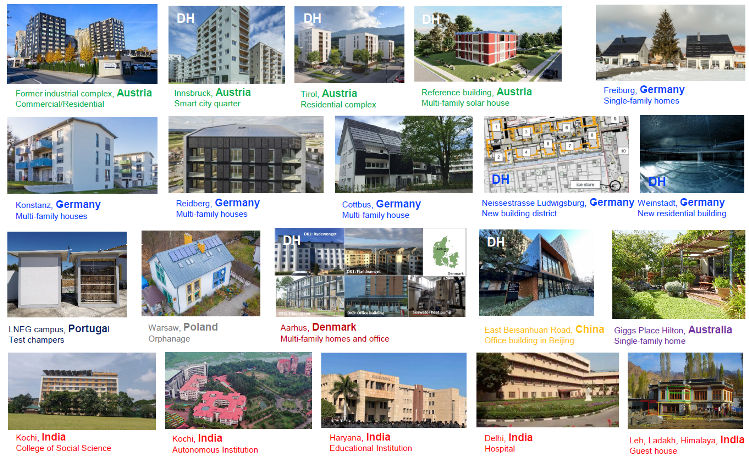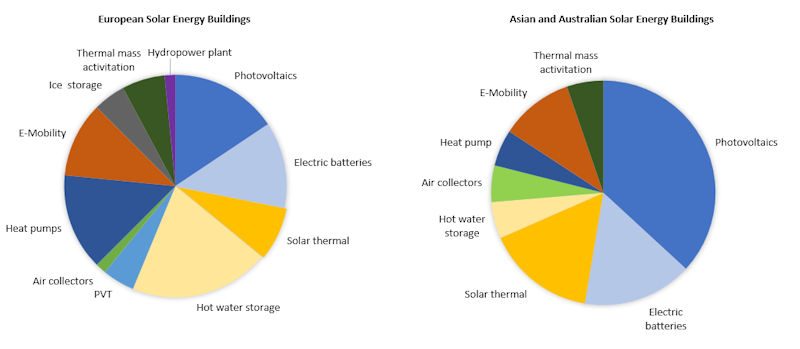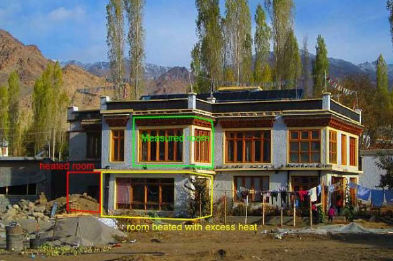Posted: October 6, 2023

The IEA Solar Heating and Cooling Programme addresses the question of what is needed to reach a high degree of self-sufficiency in solar energy buildings and blocks. A research group within the IEA SHC Task 66 on Solar Energy Buildings has identified 20 completed or planned mostly residential building projects in different climate zones around the globe and analysed existing monitoring results for these buildings. Elsabet Nielsen, Senior Researcher at the Department of Civil and Mechanical Engineering, Technical University of Denmark, presented the first results of this work in an IEA SHC webinar in September 2023. It is clearly visible that high-solar-fraction buildings in Europe use a large mix of different renewable and energy-efficient measures, whereas the same building types in Asia uses fewer technologies. The recording of the webinar is available here: https://www.iea-shc.org/solar-academy/webinar/solar-energy-buildings
Nielsen and her Task 66 team listed all the technologies used in the 20 reference building projects (see pie charts below). At first glance, it is noticeable that the variability of technologies is greater in European solar energy buildings than in Asia. While on average the 13 European building projects, use five different components to ensure a high solar coverage rate, in Asia the average is only three. This result is partly influenced by the fact that all the buildings in Europe have a hot water tank. In Asia and Australia, this is only one building out of seven. And also by the fact that the Indian and Australian solar energy buildings mostly do not require space heating.

Renewable heating and energy efficiency measures of the 13 buildings in Europe (left) and the seven in Asia and Australia (right).
Source: DTU/Task 66
In both world regions, photovoltaic systems play an important role in solar energy buildings. In Europe, they are more often combined with batteries than in Asia. The share of solar energy buildings with a solar thermal system is almost the same in both world regions (around 40 %). Different types of heat pump are more often installed in Europe’s solar energy buildings than in Asia.
In her presentation during the IEA SHC Solar Academy webinar, Nielsen introduced in more detail some of the reference buildings that showcase completely different energy supply systems.

This multi-family building in Germany with large collector field and seasonal storage reaches a solar fraction of 83 % on the thermal side.
Photo: Lukas Oppelt, TU Bergakademie Freiberg
A multi-family building in Cottbus, Germany, built in 2019, reaches an impressive 93 % self-sufficiency on the electricity side and 83 % on the thermal side – based on measured data. The building with 605 m2 living area and an annual heating consumption of 85 kWh/m2 is heated by a 100 m2 collector field on the roof, a huge heat storage of 24.6 m3 and a backup gas boiler (46.8 kW). The surplus of heat and electricity is consumed decentrally through networking and sector coupling in the neighbourhood and for charging electric cars.

Design study of a newly built neighbourhood with nine multi-family houses (left) and solar air collectors (right).
Photos: https://www.neubaukompass.de/ ITGE
A significantly different energy concept is currently being implemented in multi-family buildings in Ludwigsburg, Germany (link https://solarthermalworld.org/news/how-to-get-renewable-energy-to-buildings-in-dense-urban-areas/) reaching a heating self-sufficiency of 79 % and 28 % for electricity. There, solar air collectors together with an ice storage system serve as the heat source for a brine heat pump, providing space heating to the ten buildings with 8,600 m2 of living space. Hot water is prepared by decentralized electric continuous-flow water heaters. It is planned to monitor the system over one year to confirm efficiency and the solar proportion.

Kurja Guesthouse in Ladakh in the Himalayan region of India
Photo: Christoph Müller, Simply Solar GbR
A guesthouse in the Himalayan region of India with subarctic climate conditions, is part of the solar energy building assessment of Task 66. The guesthouse is completely heated by a solar air collector system on the roof. The solar-heated air flows through a pebble-bed storage below the ground floor of the building. Building mass activation ensures room heating even during 1 to 2 days without sun. A PV panel drives the ventilator. The measured degree of self-sufficiency for the heating is 94 %. This high share is achieved due to the cold but sunny winters that you find in many other locations around the world. Gas is used for cooking (2 gas bottles of 12 kg each per year) and this is the reason the self-sufficiency is 94 % and not 100 %.
“The case studies show a high degree of freedom and possibilities when combining different technologies from a perspective of the entire energy system for heat, cold, household electricity demand and e-mobility”, summarized Nielsen. The Task 66 Team will now analyse the available case studies further, define integrated and grid-interacting energy supply systems, and develop intelligent control concepts. The results will then be published in a report in June 2024.
Websites of organizations mentioned in this article: